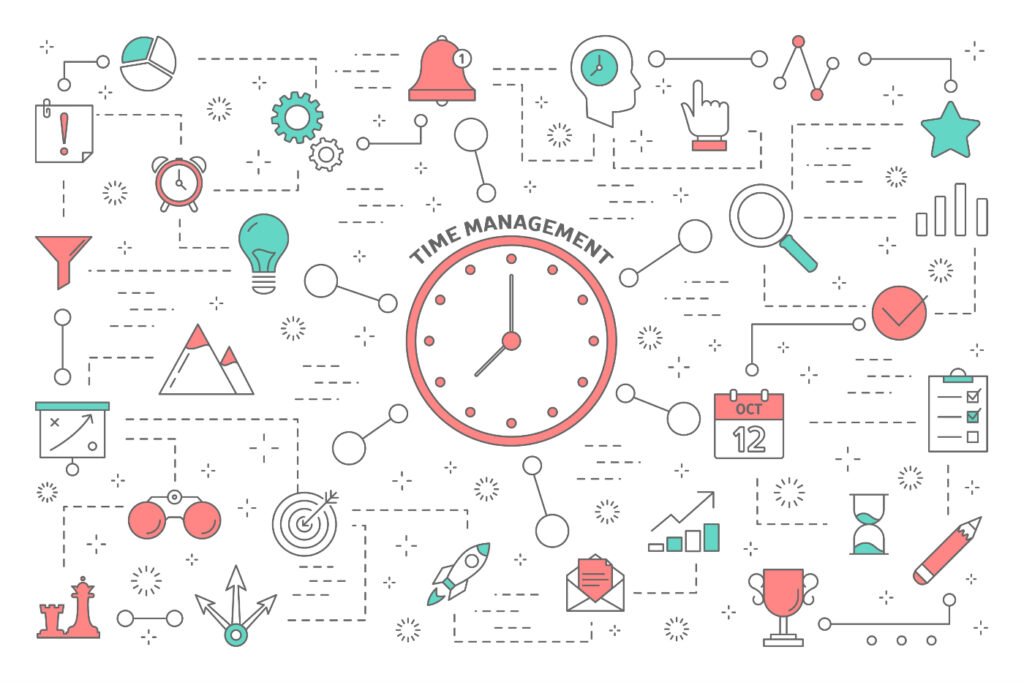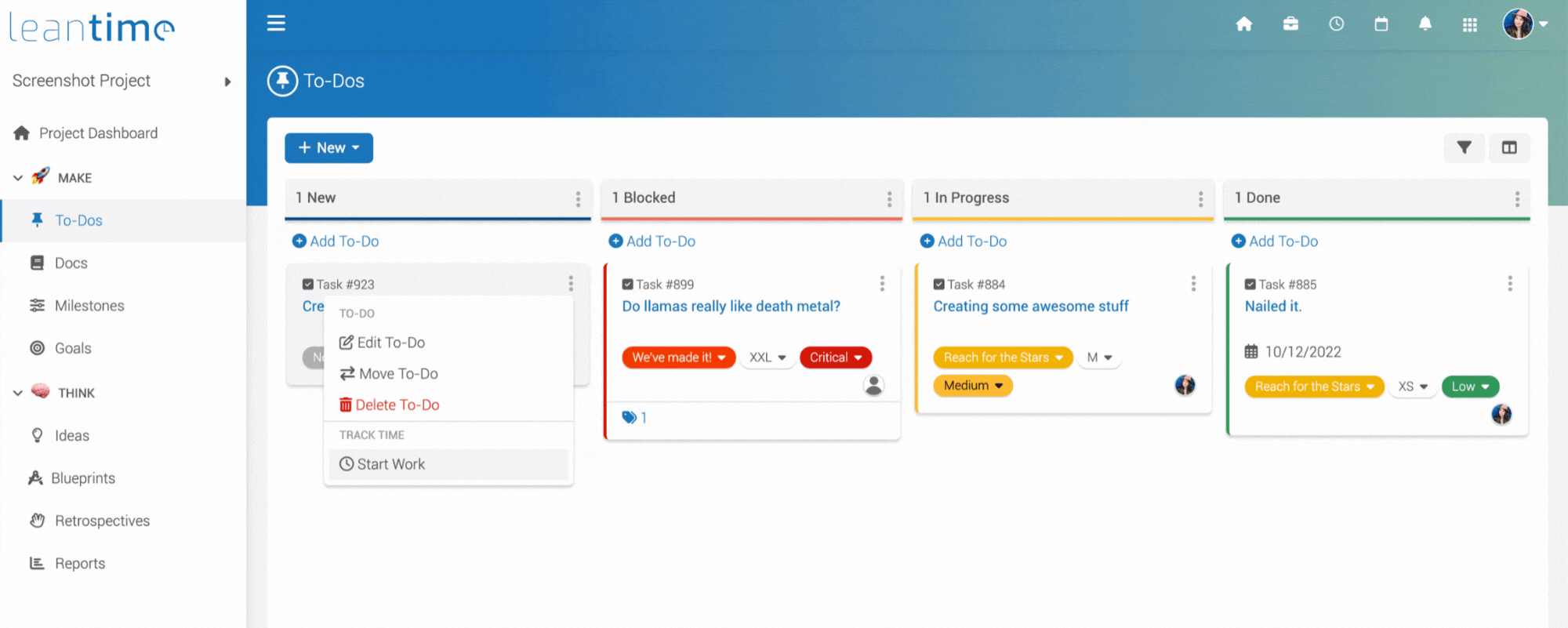Estimated reading time: 12 minutes
Time management is a critical skill that can make or break your success in various areas of life – and it isn’t always straightforward. It can be challenging to juggle numerous tasks, responsibilities, and priorities.
There are often competing demands and needs. However, there are some ways to manage time that you may not have considered before.
In this article, we’ll explore 5 time management tips and methods to get things done and to help you manage your time more effectively.
Table of contents
- What is Time Management?
- What is a Time Management Strategy?
- The Importance of Time Management
- The Best Time Management Tools & Techniques
- The Pomodoro Technique
- Time Blocking
- The Eisenhower Matrix
- The 80/20 rule for managing your time
- Leantime for Time Tracking
- Other Effective Time Management Tools
- Final Thought
- Frequently Asked Questions
What is Time Management?
Time management is a critical skill that can make or break your success in various areas of life – and it isn’t always straightforward. It can be challenging to juggle multiple tasks, responsibilities, and priorities.
There are often competing demands and needs. Setting a time limit for task completion can enhance focus and efficiency. However, there are some ways to manage time that you may not have considered before.
In this article, we’ll explore 5 time management tips and methods to get things done and to help you manage your time more effectively.
What is a Time Management Strategy?
Time management refers to planning, organizing, and allocating one’s time effectively so that you or I can get tasks done and reach the goals we are working towards.
Good time management involves prioritizing tasks, creating schedules, and avoiding time-wasting activities and distractions. Time management tools and techniques allow people to be more efficient and achieve better results with less effort. In other words, we get to work smarter and not harder.
Having more time can also reduce stress, maximize productivity, and provide a better work-life balance. Time management is a crucial soft skill that can be applied to all aspects of life, from personal to professional.
Related Blog: Top Task Management Tools for ADHD
In the fast-paced rhythm of modern life, mastering time management is paramount for achieving personal and professional success.
The quest for efficiency and productivity has given rise to many tools and techniques to help us make the most of our precious time. Below, we’ll uncover the best time management tools and techniques that can transform the way we navigate our daily tasks and responsibilities while minimizing the negative effects of frequent task switching.
The Importance of Time Management
Effective time management is the cornerstone of success in both personal and professional realms. By managing time effectively, you can prioritize tasks, set achievable goals, and allocate your time wisely, leading to a significant boost in productivity. Good time management habits enable you to stay focused on important tasks, accomplish tasks efficiently, and avoid the pitfalls of procrastination.
In the professional world, demonstrating good time management techniques is essential for career advancement. It showcases your ability to handle a workload, meet deadlines, and prioritize tasks effectively.
This not only enhances your productivity but also reduces stress levels, allowing for a better work-life balance. By mastering time management, you can maximize productivity and achieve your goals with greater ease.
The Best Time Management Tools & Techniques
Mastering time management is crucial for achieving success in both personal and professional spheres in our fast-paced world.
The quest for efficiency and productivity has given rise to many tools and techniques to help us make the most of our precious time. Below, we’ll uncover the best time management tools and techniques that can transform the way we navigate our daily tasks and responsibilities.
The Pomodoro Technique
The Pomodoro Technique is a time management methodology that was created by Francesco Cirillo in the late 1980s. The technique involves dividing your workday into short, 25-minute intervals called “Pomodoros,” separated by brief breaks.
During each Pomodoro, you are expected to concentrate exclusively on one task without any distractions, and after completing four Pomodoros, you can take a more extended break.
This technique has become incredibly popular because it helps individuals manage their time more efficiently, improves their focus, and reduces the risk of burnout. By working in short, focused bursts, you can accomplish more or similar tasks in less time, and your brain will be less exhausted.
Tip: Start with a short break of 5 minutes, then take a longer break of 15-30 minutes after 4 pomodori.
Additionally, this technique can help you avoid procrastination, as the short time intervals provide a sense of urgency that can help you stay motivated. In general, the Pomodoro Technique proves to be a valuable method for improving efficiency and effectively organizing time.
Benefits of the Pomodoro Technique
There are various benefits of the Pomodoro Technique, including:
- • Increased Focus
- • Enhanced Efficiency
- • Reduced Procrastination
- • Improved Time Management Skills
- • Mitigated Mental Fatigue
Potential Drawbacks
While the Pomodoro technique offers various advantages, it’s worth remembering a few potential drawbacks.
- • Disruption of Flow
- • Not Suitable for All Tasks
- • Over Emphasis on Good Time Management Skills

Time Blocking
Time-blocking is a highly efficient time management method that involves dividing your day into specific time slots for completing various activities. Setting time limits for each time block is crucial to ensure that you manage your time effectively and stay on track.
This technique requires you to schedule particular blocks of time for important tasks like responding to emails, making phone calls, attending meetings, or even taking short breaks, exercising, or personal time.
Read More: Unlocking the Power of Time Blocking: Tips & Techniques
This approach helps you prioritize your time more effectively by eliminating multitasking and encouraging you to focus on one task simultaneously.
When you allocate time blocks for particular activities, you can better regulate your expectations better, prioritize your work, and stay more organized.
It’s an effective way to avoid procrastination and stay on track with your daily goals. By using this technique, you’ll be able to increase your productivity and make the most of your day.
Time Blocking Benefits
There are various benefits of the time blocking, including:
- • Enhanced Focus
- • Increased Efficiency
- • Improved Time Management
- • Reduced Procrastination
- • Better Work Balance
Potential Drawbacks
While time blocking offers numerous advantages, it’s worth noting a few potential drawbacks to keep in mind.
- • Potential Burnout
- • Overcommitting
- • Learning Curve
The Eisenhower Matrix
The Eisenhower Matrix, also known as the Urgent-Important Matrix, is a popular and effective decision-making tool to help you manage your time better by focusing on the most urgent tasks. This technique involves dividing your specific tasks into four categories based on urgency and importance. Doing so lets you prioritize tasks and focus on the ones that matter most.
Urgent and Important
These tasks require immediate action, such as dealing with a crisis or meeting an important deadline. Addressing these tasks as soon as possible is essential to prevent them from becoming bigger issues.
Important but Not Urgent
These encompass crucial activities that, while important, demand little attention. Examples include project planning, reviewing goals, or acquiring new skills.
By scheduling these tasks, you can ensure that you give them the attention they deserve without sacrificing urgent tasks.
Urgent but Not Important
These tasks can be delegated to others, such as responding to emails, scheduling meetings, or handling administrative tasks. Delegating these tasks can free up your time to focus on the more critical tasks only you can do.
Neither Urgent nor Important
They can be eliminated or postponed, such as watching TV, browsing social media, or doing other non-essential activities. By removing or postponing these tasks, you can use the time effectively to focus on the tasks that matter the most.
With the help of the Eisenhower Matrix, you can prioritize your tasks based on their importance and urgency. This can be a great way to help you manage your time more effectively and help you avoid procrastination, reduce stress, and improve your efficiency.
Benefits of the Eisenhower Matrix
The Eisenhower Matrix has several advantages. These benefits include:
- • Clear Prioritization
- • Improved Decision Making
- • Increased Productivity
- • Enhanced Time Management
- • Reduced Procrastination
Potential Drawbacks
While there are plenty of perks to using the Eisenhower Matrix, it’s important to be aware of some potential downsides.
- • Overemphasis on Urgency
- • Potential for Procrastination
- • Static Nature

The 80/20 rule for managing your time
The 80/20 Rule, also referred to as the Pareto Principle, is a time management technique that can assist you in optimizing your results. 80% of your results come from 20% of your efforts. In simpler terms, 80% of the effects of most activities come from 20% of the causes.
To apply this technique in your daily life, you need to identify and focus on the most critical tasks that contribute the most to your goals and focus on them. This means that instead of trying to do everything, prioritize your tasks based on their importance and impact on your overall success.
By doing this, you’ll achieve more meaningful results while making the most of your time. Eliminating the less important tasks, you’ll also get better at learning where your time should go and prioritizing outcomes. This can help you manage your time more effectively and avoid getting sidetracked by tasks that contribute little to your goals.
Ultimately, the 80/20 rule can help you become more productive and achieve more tremendous success in both your personal and professional life.
80/20 Advantages
The 80/20 principle has several advantages, such as:
- • Improved Goal Achievement
- • Less Stress
- • Increase Profits in Business
- • Efficient Time Management
- • Enhance Productivity
- • Better Decision-Making
Potential Drawbacks
The 80/20 rule has many advantages, but it’s important to consider a few potential drawbacks.
- • Oversimplification
- • Risk of Neglect
- • Lack of Precision
- • Overemphasis on Short-Term Gains
Body Doubling
Body doubling is a practical and effective time management technique that can assist individuals with Attention Deficit Hyperactivity Disorder (ADHD) to help them stay focused and productive.
This technique involves having someone else present while an individual with ADHD works on a task, providing a sense of accountability and reducing distractions. This person can be online or offline, and their presence helps the individual with ADHD to remain on track and complete the task more efficiently.
The primary goal of body doubling is to provide support and motivation to individuals with ADHD, who often struggle with getting started independently or find distractions challenging to resist.
With the help of a supportive body double, individuals with ADHD can feel more confident and less overwhelmed while working on a task. This helpful tool is particularly helpful for people with ADHD who have trouble initiating tasks or experience difficulty sustaining attention.
Benefits of Body Doubling
There are various benefits of the body doubling, including:
- • Enhanced focus
- • Increased Accountability
- • Establishment of Routine
- • Positive Impact on Mental Health
Leantime for Time Tracking

At Leantime, we are committed to making the future of body doubling more accessible and integrated into work processes. This technique is ideal for time management software, and we are currently exploring an AI-based approach to this technique as we build out our Virtual Project Manager features.
We aim to create a more natural and seamless body-doubling experience that can help individuals with ADHD to work more effectively and efficiently. If you’re interested in being part of our pilot to test these features, please don’t hesitate to contact us.
Read Blog: The Best Planners for ADHD
Other Effective Time Management Tools
There are several methods similar to the above tools that individuals can use to manage their time effectively. Some alternatives include:
The Two-Minute Rule
The Two-Minute Rule is a popular time management principle that was first introduced by productivity expert David Allen in his book “Getting Things Done.” The rule is based on the simple idea that a task requiring less than two minutes to complete should be done immediately rather than being put off or added to a to-do list.
The principle is designed to help people reduce the number of small yet essential tasks that can accumulate over time and become overwhelming, thus freeing up more time and mental energy for more significant and complex tasks.
The Two-Minute Rule is widely regarded as a straightforward and effective technique for boosting productivity and reducing stress levels, making it a popular choice among individuals looking to optimize their time management skills.
Agile Methodology
Agile methodology is a project management and software development approach that is iterative and flexible and emphasizes adaptability, collaboration, and customer satisfaction.
It was first introduced in the software development industry as a response to the traditional, linear approach that needed more flexibility and often resulted in missed deadlines and unsatisfied customers. Agile methodology, on the other hand, focuses on delivering working software in short iterations, typically two to four weeks, and prioritizes customer feedback and involvement throughout the development process.
This helps teams quickly adapt to changing requirements, identify and address issues early on, and continuously improve product quality. Due to its effectiveness in managing complex projects, agile methodology is now being used in various industries, including finance, healthcare, and education.
Agile methodology provides a dynamic and responsive framework for project management, fostering innovation and delivering high-quality products with a focus on customer value.
Final Thought
If you’re struggling to get started, prioritize, or track time — we hear that. Getting started and organized is hard. When you finally do get going, Leantime works as a time management software with a built-in time tracker linked to your tasks.
By clicking “Start work,” a time will appear at the top of your bar and track the time spent on the task. Don’t forget to stop the work, though. It’ll keep monitoring and add it to your timesheets.
So whether you’re using Pomodoro, Eisenhower matrix, 80/20, body doubling, or the Leantime as your tools, there are time management tips and techniques to help you get through everything you need to do and hopefully more efficiently.
When it comes to your to-do lists, working smarter, and not harder, can decrease your stress and ultimately give you a better balance.
Frequently Asked Questions
While there are many time management techniques, planning stands out as the most powerful. By creating a detailed plan for your day, week, or even month, you gain a clear overview of your tasks and deadlines.
This allows you to prioritize effectively, allocate time wisely, and reduce stress. Whether you use a digital calendar, a physical planner, or a simple to-do list, the key is to consistently plan your work and work your plan.
A great way to manage your time is to “give each task a time limit.” By setting specific timeframes for each task, you’ll be more motivated to work efficiently and avoid procrastination.
• Assess Your Current Habits
• Set Clear Goals
• Create a Schedule
• Minimize Distractions
• Review and Adjust






